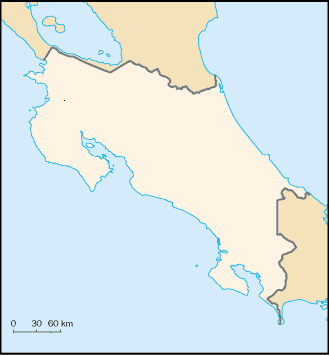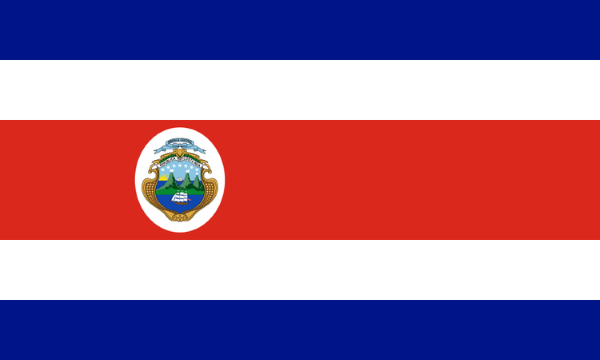Costa Rica
Military Power Ranking 2025
MPR Rank: 186th
MPR SCORE: 134
MPR Index: 0.0114 (1.0000 is perfect)
Reverse MPR Index: 0.9368 (0.0000 is perfect)
Z Score: -0.833 (standard deviations above the mean
Overview
Costa Rica ranks 186th in the 2025 Military Power Rankings. It is globally recognized for having abolished its military in 1949, establishing a unique model of national defense centered on civil policing, constitutional neutrality, and international cooperation. The country’s security is maintained by the Ministry of Public Security, with operational enforcement carried out by the Fuerza Pública, along with specialized units for border surveillance, anti-narcotics operations, disaster response, and maritime enforcement. Costa Rica’s defense posture reflects its unarmed sovereignty, emphasizing diplomatic conflict resolution, internal security, and strategic alliances in lieu of conventional armed forces.
Strengths
1. Strong Internal Security Infrastructure
Costa Rica compensates for the absence of a military with a highly structured policing system, including the Fuerza Pública, Special Intervention Unit (UEI), National Coast Guard, and Air Surveillance Service (SVA), ensuring effective control over its territory and borders.
2. Constitutionally Enforced Neutrality
The abolition of the military is enshrined in the 1949 Constitution, providing long-term legal stability and a strong international reputation for peace, which attracts diplomatic support and foreign investment.
3. International Defense Partnerships
Despite its demilitarized status, Costa Rica maintains security cooperation with the United States, Colombia, and regional Central American states, particularly in counter-narcotics efforts and disaster response readiness.
4. National Investment in Civil Services over Militarization
The absence of defense spending allows for greater allocation of resources toward education, health care, and infrastructure, reinforcing internal resilience and social stability as part of a broader national defense strategy.
Why Costa Rica Is Ranked 186th
No Military Force or Combat Capabilities: Costa Rica has no army, navy, or air force. Its law enforcement agencies cannot substitute for a traditional military in high-intensity conflict scenarios.
Lack of Strategic Deterrence or Power Projection: Without missile systems, armored forces, or air defense capabilities, Costa Rica is unable to defend against or deter state-level military threats independently.
Dependence on External Guarantees: The country’s safety relies on international norms, U.S. strategic presence in the region, and collective support frameworks, not internal defense power.
Operational Limits in Crisis Response: While effective against organized crime and natural disasters, Costa Rica’s security structure is not capable of scaling to full national defense in the event of external aggression.
Conclusion
Costa Rica’s ranking at 186th reflects its position as a peaceful, demilitarized state operating entirely outside the traditional framework of national armed forces. The Fuerza Pública and related agencies provide internal security and border enforcement, while disaster response and counter-narcotics operations are strengthened through international partnerships. Though lacking any formal military capability or strategic deterrence, Costa Rica remains a model for civil governance, diplomatic stability, and human-centric national security—a unique case in the global security landscape.
Military Strength and Force Projection
Active Security Personnel: 12,000 (police, border patrol, coast guard, and special forces)
Reserve Personnel: None
Paramilitary Forces: 2,000 (border police, tactical units)
Army Personnel: 0 (no army)
Navy Personnel: 1,000 (Coast Guard under Public Security Ministry)
Air Force Personnel: 0
Ground Forces
Main Battle Tanks (MBTs): 0
Armored Fighting Vehicles (AFVs): 0
Artillery Pieces (Towed & Self-Propelled): 0
Multiple Launch Rocket Systems (MLRS): 0
Air Surveillance Division
Combat Aircraft: 0
Attack Helicopters: 0
Transport Aircraft: 4+
Training Aircraft: 2+
Aircraft Breakdown:
Utility helicopters and light fixed-wing aircraft used for surveillance, transport, and disaster relief
No armed aviation capability
Naval Forces (Coast Guard)
Warships: 10+ (patrol boats)
Submarines: 0
Frigates/Corvettes: 0
Patrol Boats: 10+
Naval Vessel Breakdown:
Fast patrol craft provided by the United States and South Korea
Operations include anti-drug trafficking, search and rescue, and environmental protection
Missile Capabilities
Costa Rica does not operate any missile systems. The country maintains no military-grade weaponry, and its national security policy excludes offensive or strategic weapons development.
Strategic Partnerships
Costa Rica maintains strong bilateral ties with the United States, receiving support through the Central America Regional Security Initiative (CARSI) and U.S. SOUTHCOM. It collaborates closely with Colombia, Panama, and Nicaragua on border control and counter-narcotics. The country participates in UN peace initiatives and climate-security forums.
Military History & Combat Experience
Costa Rica’s military history effectively ended in the mid-20th century, when the country took the unprecedented step of abolishing its armed forces. Since then, its real-world security experience has centered on internal policing, counter-narcotics operations, and natural disaster response, with limited engagements in regional law enforcement initiatives.
Abolition of the Military – Aftermath of the 1948 Civil War
The Costa Rican Civil War of 1948 was the country’s last military conflict. Following the victory of José Figueres Ferrer’s revolutionary forces, the army was constitutionally abolished in 1949, and the Fuerza Pública was established to handle all internal and national security responsibilities. This historic move laid the foundation for Costa Rica’s unique civil-security doctrine and ended its participation in conventional warfare.Participation in Regional Security Frameworks (Post-1990s)
Although demilitarized, Costa Rica has contributed personnel and logistical support to regional anti-narcotics operations under frameworks like the Central American Security Commission and U.S.-led Joint Interagency Task Force South (JIATF-S). These efforts focus on intercepting drug trafficking routes through the Caribbean and Pacific corridors, with U.S. Coast Guard and DEA collaboration.Internal Operations Against Transnational Crime
Costa Rica’s Special Intervention Unit (UEI) and Fuerza Pública have been involved in numerous internal counter-crime operations, particularly targeting drug cartels, illegal arms trafficking, and human smuggling networks along the Nicaraguan border. These operations simulate aspects of combat in urban and rural settings but are conducted entirely within a law enforcement framework.Disaster Response and Humanitarian Operations
Due to its seismic and meteorological vulnerability, Costa Rica has built significant expertise in disaster response operations. After major earthquakes (e.g., Limón 1991, Cinco Esquinas 2022) and hurricanes, the Fuerza Pública, Fire Department, and Red Cross coordinate in emergency logistics, search and rescue, and population protection, reflecting the country’s security emphasis on civil resilience.
Costa Rica has not engaged in war for over seven decades. Its non-military security forces have developed operational proficiency in police-led enforcement, drug interdiction, and disaster relief, but it remains unarmed in conventional defense terms. The country’s historical decision to forgo military power continues to shape its identity as a neutral, stable, and cooperatively defended nation.
General Information
Demographics and Geography
Population: ~5.3 million (2024 est.)
Population Available for Military Service: ~2.2 million
Geographic Area: 51,100 km²
Land Boundaries: 661 km
Bordering Countries: Nicaragua, Panama
Coastline: 1,290 km (Pacific Ocean and Caribbean Sea)
Climate: Tropical and subtropical; dry season (December to April), rainy season (May to November)
Terrain: Coastal plains separated by rugged mountains including over 100 volcanic cones
Natural Resources: Hydropower, forest products, fish, arable land
Proven Oil Reserves: None
Proven Natural Gas Reserves: None
Economic Indicators
Defense Budget (2025): ~$100 million USD (allocated for internal security and public order)
Defense Budget as % of GDP: ~0.4%
GDP (PPP): ~$136 billion USD
GDP per Capita (PPP): ~$25,500
External Debt: ~$44 billion USD
Military Expenditure Trend (last 5 years): Stable; focused on police modernization and border security
Military Infrastructure and Readiness
Military Service Obligation: None (military abolished in 1949)
Primary Defense Focus: Internal security, counter-narcotics, and border control
Military Industry Base: None
Cyber/Electronic Warfare Capability: Developing; cybercrime units within public security forces
Nuclear Warhead Inventory: None (non-nuclear state)
Major Military Districts / Commands: No military; Public Force operates under Ministry of Public Security
Missile Inventory Highlights: None
Reservist Call-up Readiness / Timeline: Not applicable
Reservist Force Size: N/A
Space, Intelligence, and Strategic Infrastructure
Space or Satellite Programs: Minimal; civilian-led space science programs
Military Satellite Inventory: None
Intelligence Infrastructure: Directorate of Intelligence and Security (DIS) under Ministry of Presidency
Intelligence Sharing Partnerships: United States, regional organizations
Airports (Total): ~160 (including airstrips)
Major Military Airports: Juan Santamaría International Airport (dual-use for emergency and police operations)
Naval Power and Maritime Logistics
Merchant Marine Fleet: Moderate
Major Ports: Puerto Limón, Caldera
Naval Infrastructure: Operated by Coast Guard (Servicio Nacional de Guardacostas)
Naval Replenishment Capability: Basic coastal and harbor facilities
Domestic Mobility and Infrastructure
Railway Network: ~278 km (limited use)
Roadways: ~39,000 km
Energy and Fuel Logistics
Oil Production: None
Energy Imports: Imports refined petroleum products
Strategic Petroleum Reserves: Low; government-held stocks managed by RECOPE
Defense Production and Strategic Forces
Domestic Defense Production: None
Military Installations (Domestic): Law enforcement training and logistics facilities in San José, Puntarenas
Military Installations (Overseas): None
Foreign Military Personnel Presence: U.S. cooperation on counter-narcotics operations
Defense Alliances: Regional coordination with Central American Integration System (SICA); bilateral ties with U.S.
Strategic Airlift Capability: None
Wartime Industrial Surge Capacity: Very low
Research and Industry Support
Defense R&D Investment: None
Key Wartime Industries Beyond Defense: Electronics, medical devices, agriculture, logistics infrastructure
Political and Administrative Structure
Capital: San José
Founding Date: September 15, 1821 (independence from Spain)
System of Government: Democratic presidential republic



